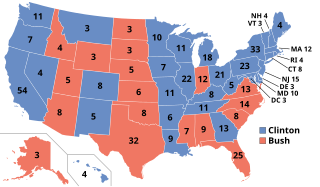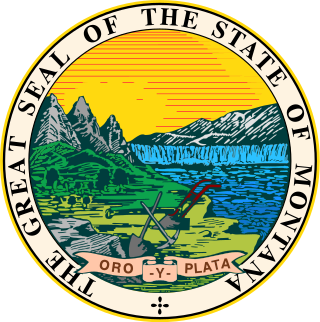
The 1988 United States House of Representatives elections was an election for the United States House of Representatives in November 8, 1988, to elect members to serve in the 101st United States Congress. They coincided with the election of George H. W. Bush as president. Although Bush won with a strong majority, his Republican Party lost a net of two seats to the Democratic Party, slightly increasing the Democratic majority in the House. It was the first time since 1960 that an incoming president's party lost seats in the House.

The 1980 United States House of Representatives elections was an election for the United States House of Representatives on November 4, 1980, to elect members to serve in the 97th United States Congress. They coincided with the election of Ronald Reagan as president, defeating Democratic incumbent Jimmy Carter. Reagan's victory also allowed many Republican House candidates to secure elections. The Republicans gained a net of 35 seats from the Democratic Party. The Democrats nonetheless retained a significant majority, unlike the Senate elections, where Republicans gained control of the chamber. However, many Democratic congressmen from the south frequently took conservative stances on issues, allowing Republicans to have a working ideological majority for some of President Reagan's proposals during his first two years in office.

The 1962 United States elections were held on November 6 to elect the members of the 88th United States Congress. The election occurred in the middle of Democratic President John F. Kennedy's term. The Republican Party picked up four seats in the House of Representatives. Still, the Democrats retained strong majorities in both houses of Congress.

The 2008 United States elections were held on Tuesday, November 4, 2008, during the war on terror and the onset of the Great Recession. It was a Democratic wave, Democratic Senator Barack Obama of Illinois defeated Senator John McCain of Arizona by a wide margin, and the Democrats bolstered their majorities in both chambers of Congress. This is the first Democratic trifecta in the 21st century and the first since 1995.

The 2004 United States elections were held on Tuesday, November 2, 2004, during the early years of the war on terror and after the 2003 invasion of Iraq. Republican President George W. Bush won re-election and Republicans retained control of Congress.

Elections in Wisconsin are held to fill various local, state, and federal seats. Special elections may be held to fill vacancies at other points in time.

Elections in Pennsylvania elect the five state-level offices, the Pennsylvania General Assembly, including the senate and house of representatives, as well as the state's congressional delegation for the United States Senate and the United States House of Representatives. Presidential elections are held every four years in Pennsylvania. The state is one of the most competitive nationally, with narrow victories that alternate between the parties across all major offices. On the presidential level, the state has been considered a swing state throughout its entire history as it only voted for the nationwide loser on only 10 occasions. Meaning it has voted for the national winner 83% of the time, as of 2020.

The 1980 United States elections were held on Tuesday, November 4. Republican presidential nominee Ronald Reagan defeated incumbent Democratic President Jimmy Carter. Republicans also won control of the Senate, though Democrats retained a majority in the House of Representatives. The election is sometimes referred to as part of the "Reagan Revolution", a conservative realignment in U.S. politics, and marked the start of the Reagan Era.

Elections in Vermont are authorized under Chapter II of the Vermont State Constitution, articles 43–49, which establishes elections for the state level officers, cabinet, and legislature. Articles 50–53 establish the election of county-level officers.

The 1996 United States elections were held on November 5. Democratic President Bill Clinton won re-election, while the Republicans maintained their majorities in both houses of the United States Congress.

The 1992 United States elections elected state governors, the President of the United States, and members of the 103rd United States Congress. The election took place after the Soviet Union crumbled and the Cold War ended, as well as the redistricting that resulted from the 1990 Census. The Democratic Party won control of the presidency and maintained their control of both chambers of Congress. This is the first Democratic trifecta since the Republican victory in the 1980 elections and the last one during the 20th century.

The 1984 United States elections was held on November 6, and elected the members of the 99th United States Congress. Republicans won a landslide victory in the presidential election, picked up seats in the House of Representatives, and successfully defended their Senate majority.

The 1972 United States elections was held on November 7, and elected the members of the 93rd United States Congress. The election took place during the later stages of the Vietnam War. The Republican Party won a landslide victory in the presidential election, and picked up seats in the House, but the Democratic Party easily retained control of Congress. This was the first election after the ratification of the 26th Amendment granted the right to vote to those aged 18–20.

The 1968 United States elections were held on November 5, and elected members of the 91st United States Congress. The election took place during the Vietnam War, in the same year as the Tet Offensive, the assassination of Martin Luther King, Jr., the assassination of Robert F. Kennedy, and the protests of 1968. The Republican Party won control of the presidency, and picked up seats in the House and Senate, although the Democratic Party retained control of Congress.

The 1964 United States elections were held in the United States on November 3, 1964, to elect the President of the United States and members of the 89th United States Congress. The elections were held during the Civil Rights Movement and the escalation of the Vietnam War. President Lyndon B. Johnson crushed Senator Barry Goldwater of Arizona in the presidential election, and Johnson's Democratic Party added to their majorities in both chambers of Congress. This was the first presidential election after the ratification of the 23rd Amendment, which granted electoral votes to Washington, D.C.

The 1952 United States elections were held on November 4, 1952, during the Cold War and the Korean War. General of the Army Dwight D. Eisenhower won the White House in a landslide over Democratic Governor Adlai Stevenson of Illinois and Republicans narrowly took control of Congress, giving Republicans their first trifecta since the Great Depression. This is the last election in the 20th century and until 2000 that Republicans won control of Congress and the presidency. For the rest of the century, Republicans would often still win the presidency without full control of Congress.

Montana became a territory May 28, 1864 and the first delegation created nine counties: Beaverhead, Big Horn, Chouteau, Deer Lodge, Gallatin, Jefferson, Edgerton, Madison, and Missoula. Montana became a state on November 8, 1889.

The 1860 United States elections elected the members of the 37th United States Congress. The election marked the start of the Third Party System and precipitated the Civil War. The Republican Party won control of the Presidency and both houses of Congress, making it the fifth party to accomplish such a feat. The election is widely considered to be a realigning election.

This is a list of past elections in the U.S. state of Tennessee. Tennessee's politics are currently dominated by the Republican Party. Republicans currently hold both of the state's U.S. Senate seats, a majority of Congressional seats, and the state legislature. Democratic strength is largely concentrated in Nashville, Memphis, and parts of Knoxville, Chattanooga, and Clarksville. Several suburban areas of Nashville and Memphis also contain significant Democratic minorities. Tennessee is one of thirteen states which holds its presidential primaries on Super Tuesday. Tennessee does not require voters to declare a party affiliation when registering. The state is one of eight states which require voters to present a form of photo identification.

This is a list of elections in the U.S. state of Nevada. Nevada is a swing state in state and federal elections, with margins that typically are under five percent. Unique to the state is the "None of These Candidates" voting option for all statewide and presidential and vice-presidential election ballots. This option is listed along with the names of individuals running for the position and is often described as "none of the above". The option first appeared on the Nevada ballot in 1975.




















